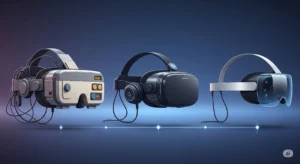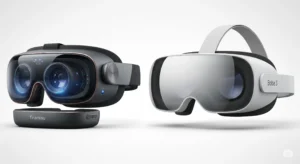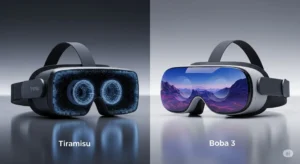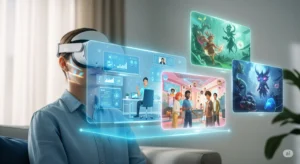Meta’s Stunning VR Prototypes A Hyperrealistic Future Unveiled
How Tiramisu and Boba 3 reveal Reality Labs’ two-pronged strategy to solve visual fidelity and long-wear comfort — and what that means for the next generation of VR.
1. Introduction

What if the line between the virtual and the real wasn’t a technological barrier, but simply a matter of displays, optics, and comfort finally getting out of the way? What if a VR headset felt less like a bulky helmet and more like advanced eyewear?
At SIGGRAPH 2025, Meta’s Reality Labs Research lifted a corner of the curtain. The lab unveiled multiple research prototypes — most notably Tiramisu and Boba 3. These devices don’t aim to be retail products but instead explore the limits of two critical frontiers: visual realism and immersive field of view/comfort. Instead of chasing a single “best” headset, Meta is investigating two distinct routes to the same destination: VR that looks, feels, and functions as an everyday piece of tech.
This post is an in-depth look at what those prototypes reveal, the engineering trade-offs Reality Labs is willing to make, and how those experiments could reshape gaming, social VR, remote work, and the broader notion of the “metaverse.”
2. Introducing the Prototypes — The “What”

Before getting technical, here is a concise overview of the two headliners.
Tiramisu — The Hyperrealism Prototype
Tiramisu is Reality Labs’ exploration of near-photorealistic VR. The OPALS (Optics, Photonics, and Light Systems) team focused on achieving exceptionally high angular resolution, extreme brightness and contrast, and color fidelity that approaches or, in specific metrics, exceeds what we are used to seeing on modern flat screens. Tiramisu delivers these gains at a cost: a bulky, heavy optical train that sacrifices field of view and, for now, comfort.
Key claims reported: Tiramisu achieves roughly 90 pixels per degree (PPD), ~1,400 nits of brightness, and a contrast ratio multiple times greater than Quest-class devices. These numbers are intended to demonstrate what hyperrealistic VR could look like.
Boba 3 — The Ultrawide, Immersive

Where Tiramisu chases pixel density and visual fidelity, Boba 3 chases coverage. Developed by Meta’s Display Systems Research (DSR) team, Boba 3 targets ultra-wide fields of view—approximately 180° horizontal × 120° vertical—intending to cover much more of the natural human visual field. This is achieved through a different set of optical and display trade-offs, including larger, high-resolution displays (with some outlets citing 4K×4K per eye). While its form factor is closer to current Quest devices, it still raises enormous rendering, bandwidth, and power demands that currently make it impractical as a consumer, standalone device.
Meta has framed both devices as research prototypes to be demoed at SIGGRAPH, not necessarily products headed to shelves. They are, however, powerful signposts that indicate which technical problems Reality Labs thinks are worth solving.
3. The Deep Dive — The “How” and “Why”
This is the meat of the post: unpacking Meta’s engineering choices and exploring the strategic case behind two very different prototypes.
3.1 Form Factor & Design Philosophy — Two Paths to the Same Goal
Reality Labs’ twin prototypes represent two complementary philosophies:
- Tiramisu (Display First): Prioritize image quality above all else. The OPALS team is effectively asking: how good could VR look if we threw engineering resources at displays and optics, without worrying about immediate consumer constraints?
- Boba 3 (Immersion & Comfort): Expand the envelope of peripheral immersion while keeping the headset’s physical ergonomics closer to everyday wear. The DSR team is asking: how much of our natural vision must a headset cover before VR truly feels like a replacement for a screen?
Why both? Because the VR adoption problem has two distinct hurdles: achieving convincing realism and providing comfortable, all-day immersion. Solving one is progress; solving both is what will make VR an everyday platform for work and life. Meta’s dual approach signals its commitment to pursuing both fronts simultaneously, understanding that the eventual consumer sweet spot will be a synthesis of these experiments.
3.2 Technical Specifications — What the Numbers Mean
Below are the most commonly reported technical claims and what they imply. Note: specifics differ slightly across outlets and some numbers are reported as “research metrics” rather than final hardware specs.
Tiramisu — headline figures and interpretation
- Angular resolution: ~90 PPD (pixels per degree). For reference, most consumer headsets today are in the 20–30 PPD range. 90 PPD pushes visual acuity to a point where fine textures and small details look truly crisp, enabling “hyperrealistic” visuals.
- Brightness: up to ~1,400 nits. This is far higher than typical headset output and makes HDR scenes pop. Higher nit counts also reduce the impression that the scene is a dim window.
- Contrast: Reported to be multiple times better than Quest-class devices, which is crucial for perceived realism.
- Field of View (FOV): Tiramisu reportedly sacrifices wide FOV. This is a critical trade-off to concentrate pixels where the eye is looking and demonstrate pixel density limits.
Implications: Tiramisu is a proof-point that above-retinal pixel density and HDR brightness can be achieved in a head-mounted display. But the optics needed to deliver those pixels currently make the headset bulky and narrow-FOV—fine for a lab demo, less so for a mass product.
Boba 3 — headline figures and interpretation
- Field of View: ~180° horizontal × 120° vertical, an order-of-magnitude jump in peripheral coverage compared to mainstream devices. The goal is to reach something closer to the natural human field of view and reduce the “goggles” effect.
- Resolution: Some coverage reports 4K × 4K per eye and roughly 30 PPD at extremely wide FOVs in lab scenarios.
- Weight & Form: Boba 3 is reportedly closer to a consumer headset form factor, but still carries significant weight and power requirements.
Implications: Boba 3 demonstrates that you can push FOV toward human vision—but doing so at practical pixel densities requires huge rendering horsepower, advanced compression, and novel foveated rendering pipelines.
3.3 The VR Experience — What Using These Headsets Might Feel Like
Let’s translate specs into subjective experience.
- Tiramisu — “Look Closely”: Using Tiramisu would be about seeing rather than feeling. Imagine inspecting a virtual painting: brush hairs, paint microstructures, and subtle specular highlights look like you’re inspecting a real canvas. The trade-off: because the device compresses pixels into a narrow, ultra-sharp sweet spot, your peripheral world may feel limited. For artists, architects, and simulations where visual fidelity trumps immersion, this is a huge leap.
- Boba 3 — “Be There”: Boba 3’s promise is presence through coverage. With a 180° horizontal FOV, your peripheral vision is filled, and environments feel more continuous. For social VR, training, and games where situational awareness matters, the bigger FOV could be transformative.
4. The Broader Implications — What’s Next

With prototypes like Tiramisu and Boba 3, Reality Labs is sending a multi-layered message: the path to mainstream VR isn’t linear. The lab is pursuing multiple axes of progress simultaneously, and each axis unlocks different applications.
A Two-Front Strategy: Display Fidelity vs. Wearability
Meta’s research shows it believes the future mass market requires both: ultra-high fidelity to convince the senses and large, natural fields of view so people can live in VR for hours. The winner for consumers will likely be a synthesis: the sweet spot where high visual fidelity and broad coverage meet an ergonomic, energy-efficient, and affordable package.
Rendering, AI, and the Rise of Smart Upscaling
The prototypes demonstrate two practical bottlenecks: rendering horsepower and power/heat. The likely bridge technologies will include advanced foveated rendering, AI superresolution/upscaling, and more efficient codecs. This implies an increasing coupling between device hardware and sophisticated real-time AI graphics techniques.
Productization Timeline — From Lab to Living Room
Prototypes are not promises of imminent products. They are experiments to test user perception and feasibility. Historically, Reality Labs’ research often trickles into consumer devices over multiple product cycles—measured in years, not months. Expect incremental borrowings from these prototypes into consumer lineups like Quest successors rather than a direct shipment of Tiramisu or Boba 3 in their shown forms.
5. Conclusion & Call to Action
Tiramisu and Boba 3 are clarifying statements about where Meta thinks VR can—and should—head. One prototype argues that achieving visual parity with the real world matters; the other argues that coverage and comfort matter just as much.
The likely practical path forward is a hybrid: consumer devices will pull visual advances and ergonomic improvements into a balanced, affordable product over several iterations. But these research prototypes accelerate the debate about what tradeoffs are acceptable and which innovations are worth chasing.
If you are a developer, designer, or VR enthusiast, here are three practical takeaways:
- Design with multiple render paths in mind. Expect more devices with variable PPD and FOV.
- Invest time in foveated and upscaling techniques. AI upscaling is a key enabler for future headsets.
- Think beyond gaming. Hyperrealism and ultrawide coverage will unlock enterprise use cases that justify early ticket prices.
Which vision excites you more: Tiramisu’s stunning realism or Boba 3’s enveloping presence? Let us know in the comments.
Sources & Further Reading
(Selected reporting and Meta’s own research overview — the key sources used in this post.)
- Meta Reality Labs Research — “Windows on the Future: Reality Labs Research to Demo New Prototype VR Headsets at SIGGRAPH 2025.” (Meta blog / press overview).
- The Verge — coverage of Meta’s prototype headsets and SIGGRAPH demo context.
- PC Gamer — technical breakdown of Tiramisu and Boba 3, including rendering and GPU observations.
- UploadVR — detailed reporting on OPALS and DSR papers and what they mean for display systems research.
- Android Central — hands-on style reportage summarizing specs and tradeoffs.
- HotHardware, Wareable, and additional coverage corroborating specs and demo context.
- iOS 26: All New Features, Release Date & How to Install
FAQ — Tiramisu, Boba 3, and the Future of Meta VR
Q1: Are Tiramisu and Boba 3 consumer products?
No, both headsets are research prototypes developed by Meta’s Reality Labs. They are not available for purchase and may never be released in their current form. Instead, they serve as testbeds for next-generation VR display, optics, and comfort innovations.
Q2: What makes Tiramisu special?
Tiramisu is a “hyperrealism” prototype, featuring an exceptionally high angular resolution (~90 PPD), extreme brightness, and high contrast. Its purpose is to demonstrate what is possible for visual fidelity in a VR headset.
Q3: What makes Boba 3 special?
Boba 3 is an “ultrawide” prototype designed to push the boundaries of immersion by offering a massive field of view (up to 180° horizontal). This is intended to reduce the “goggles” effect and cover more of the human visual field.
Q4: How do they compare to current Meta products like the Quest 3?
The Quest 3 is a commercially available, mass-market VR headset designed for broad accessibility. Tiramisu and Boba 3, by contrast, push experimental boundaries — higher display fidelity, wider FOV, and new comfort paradigms — at the expense of production readiness.
Q5: Will these technologies appear in Meta’s next consumer headset?
Likely in some form. Meta’s research prototypes often inform features that eventually make their way into retail models, though usually several years later and in a more cost-effective form.
Q6: How do these prototypes fit into Meta’s metaverse vision?
By addressing VR’s two biggest hurdles — visual realism and all-day comfort — they bring Meta closer to a metaverse where people can spend long periods immersed in virtual spaces without compromise.
Q7: How soon could we see similar headsets on the market?
Mass-market versions of these technologies might emerge within the next 3–5 years, depending on manufacturing scalability, cost, and consumer demand.
